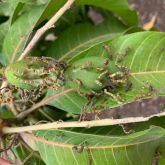Mango shoot looper
Alert
Have you seen Mango shoot looper?
Mango shoot looper has recently been detected in Australia for the first time.
The pest is known to be present in Far North Queensland, north of Cardwell. If you suspect you have found mango shoot looper in other areas of Queensland, contact the Department of Agriculture and Fisheries on 13 25 23.

Mango shoot looper larvae on leaf with pupae

Damage to mango flower panicles

Mango shoot loopers feeding on mango flower

Adult Mango shoot looper moth
Mango shoot looper is a type of moth found in several parts of Asia.
Mango shoot looper larvae feed voraciously on mango tree leaves – leaving only the midribs and veins. They also feed on tender shoots, flowers and immature fruit, and can severely damage tree canopies.
Mango shoot looper was first confirmed in Queensland in September 2021.
Scientific name
Description
Adults
- Adult moths are very pale brown or cream in colour.
Larvae
- Larvae vary in colour from yellow to black, with a mottled or 'tiger' patterned appearance.
- Full grown larvae are around 1.7–2.2cm long.
- Larvae have a 'looping' appearance when moving, and may make silken threads that hang vertically between flower panicles and leaf material. These threads allow them to move on the plant to reach new feeding areas.
Pupae
- Pupae are typically 8 or 9mm long.
- Newly formed pupae have a distinctive triangular shape, are green in colour and darken to brown before adult emergence.
- Pupae may be seen on upper surfaces of leaves in large numbers.
Plant damage
- Infestations can cause leaf defoliation, reduced photosynthesis and fruit and flower damage resulting in reduced fruit production.
Distribution
Mango shoot looper is found in several parts of Asia including Hong Kong, Philippines, Malaysia, Singapore, Thailand, Taiwan, Indonesia, India, the North-eastern Himalayan region and Guam.
In Queensland, the pest has been detected in the Mareeba/Dimbulah mango production district, northern Atherton Tablelands, and in the Wet Tropics north of Cardwell. Detections outside of this area are likely as the pest spreads naturally.
Hosts
Mango (Mangifera indica) and lychee (Litchi chinensis) are known hosts, although related plants such as rambutan, longan, cashew and pistachio should be considered potential hosts.
Life cycle
The insect completes its full life cycle in 15–19 days, and the larval period is typically 8 or 9 days.
Impacts
Mangoes are an important crop in Queensland. The Australian mango industry produces about 75,000 tonnes of fruit annually, providing a gross value of production at the farm gate of about $200 million per year. Queensland grows 67% of the national crop.
Mango shoot looper is a threat to commercial mango production but, due to having only been found recently, its broader impact is currently unknown. Severe infestations may cause 80–100% leaf and flower damage on affected trees and significant crop losses due to damage to flowers and immature fruit if uncontrolled.
Mangoes and lychees are common backyard trees in Queensland, so home gardeners may also be affected.
How it is spread
Adult mango shoot loopers can fly and spread naturally in localised areas from tree to tree. Their spread may be enhanced by strong winds.
Mango shoot loopers may also be spread by human-assisted movement of infested plant material.
Moths are attracted to lights of vehicles and caravans. Road traffic may inadvertently move moths. Larvae and pupa can drop onto vehicles parked under affected trees.
Monitoring and action
Inspect mango and lychee trees for caterpillars stripping leaves and/or flower panicles. Inspect new shoots and immature fruit for similar symptoms.
Small larvae are difficult to see. To monitor, vigorously shake flower panicles or new flush into a tray or bucket.
The mango shoot looper appears to be resistant to some older chemical pesticides, in particular, the synthetic pyrethroids. These pesticides should be avoided. Only use pesticides that are registered or permitted for your crop.
Search for permits in the registered chemicals database at Australian Pesticides and Veterinary Medicines Authority (APVMA).
If you find evidence of mango shoot looper outside Far North Queensland, report the incident as soon as possible to the Department of Agriculture and Fisheries on 13 25 23.
The department can also advise on control strategies and appropriate chemicals for use.
Prevention
Legal requirements
If you think you have found Mango shoot looper, you must take all reasonable and practical steps under your control to minimise any associated risks. This is called a general biosecurity obligation (GBO).
Further information
Contact the Department of Agriculture and Fisheries on 13 25 23.